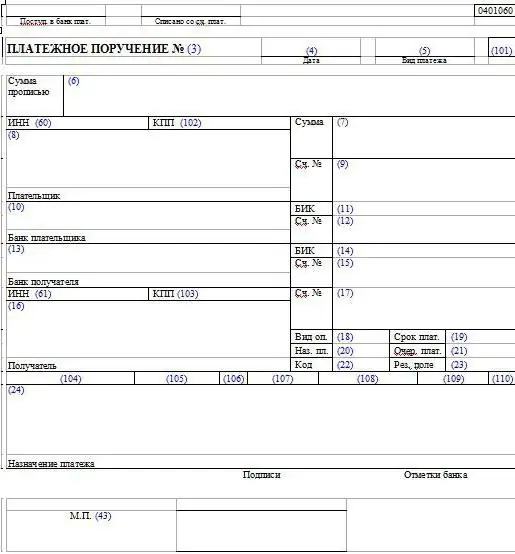2026 Author: Howard Calhoun | [email protected]. Last modified: 2025-06-01 07:12:56
Most Russian citizens know the concept of a payment order, but are not familiar with its full content. If you fill out the document incorrectly, make blots or errors, it may be invalidated. Therefore, it is important to know all the constituent elements of this bank paper.
Essence of payment order
This is a banking document, with the help of which the owner of settlement or personal accounts instructs the organization servicing his financial resources to transfer a certain amount of money by debiting from his account to the one specified in the order.
Most citizens who do not know the specifics of filling out a payment order prefer not to use this method when making payments. This position is incorrect. This document allows you to actually implement any process not prohibited by law to transfer funds from the owner's bank account to another account.
Features of filling in payment type orders are enshrined in a regulatory document. These conditions are established by Order No. 107n,approving the rules for indicating the necessary information in the appropriate columns. Compliance with these requirements regarding the specifics of filling out a payment order (sample below) is strictly necessary due to the fact that all documents submitted to the bank for transferring funds from account to account are processed automatically by the computer, and any inaccuracy will lead to invalidation of the paper. At the same time, it does not matter at all in what form the order was filled out - in writing or in the form of an electronic document generated by a computer sent via the Internet.

Despite the fact that the form developed by the Russian Central Bank is complex, not the slightest blot is allowed in the process of filling it out. Each cell must include the relevant data entered correctly and correctly. If there is at least one inaccuracy, the payment order to the bank will be canceled. Especially this situation can cause serious problems if the document was used to pay any mandatory payments, fines or taxes.
It is extremely important not only to correctly fill out the relevant documents, but also to know the options and cases of their use when making payments.
Options for using orders
There are many areas of application for documents of this type. Payment by payment order can be carried out in the following directions:
- payment of funds as an advance payment for the supply of various goods, the provision of any range of services orperforming assigned work;
- actual payment for goods delivered, services rendered or work performed;
- payment of mandatory contributions, fees or taxes to the relevant budget at any level, depositing funds into various off-budget funds, payment of forfeits in the form of pen alties and fines that may be charged by inspection bodies or counterparties under contracts;
- depositing money towards payments on consumer or mortgage loans;
- payment of various periodic payments, the introduction of which is due to the agreement concluded by the payer;
- transfer of funds to other citizens on a voluntary basis, free of charge, under various agreements, court decisions or regulatory legal documents.
Types of orders
Payment orders (sample below) are filled in different cases in different ways. Therefore, it is important to distinguish between the types of such documents. In total, Russian legislation approved two types of instructions: early and urgent.
The key differences of the second type from the first are as follows:
- Funds under a payment order are paid in the form of an advance, that is, they are transferred until the completion of any work, until the provision of specific services or until the full delivery of the entire volume of goods.
- Money is paid after the goods are shipped, the work is completed and secured by the signing of the relevant act, the service is completed in full.
- Finance is transferred to the other party in installments. This method is most often used when it comes tosettlements for large totals (for example, the delivery of a completed house).

Russian law gives citizens and organizations the right to partial payment of the amount indicated in the corresponding field of the payment order, if the amount declared by the other party is not enough to fully repay the account. In this case, an appropriate note is made in the order by the banking organization making the transfer.
Document forms and terms of validity
Before considering the features of filling in the payment order columns (personal income tax from the organization, fines, other payments), it is important to understand what forms of the document are used in the calculations and what are their validity periods.
There are two main forms of payment documents: electronic and paper. When using the first option, payments are made through the use of the "Client-Bank" program. At the same time, there is no need to print documents on paper (if a copy is not needed for submission to any authority).
When making payments using the second option, you must personally come to the bank to transfer funds.
Those who prefer to use the first payment method should be aware that banks independently establish the rules for processing documents, methods for their transfer and options for protecting transfers between financial organizations (in the part that is not regulated by the relevant Order of the Ministry of Finance).
Validity period of the payment document for its presentation to the bank orcredit organization (institution) does not exceed ten days. In this case, the countdown begins after the day when the document was generated by the payer (or the financial institution making the payment).
Within a ten-day period, the client must present the paper to the bank for payment. The period of execution of the order by the bank is calculated separately.
Procedure for making settlements through orders
All settlement entities that transfer funds through the use of payment orders (individual entrepreneurs, citizens, legal entities, and so on) must know all the stages of payment
The process of making financial transfers consists of five stages:
- The first stage is the submission of a payment document by the client to the bank. The paper must be prepared in four or five copies (depending on the procedure established by the financial institution). After that, the bank gives one copy back to the client with a mark of receipt. This seal is a form of bank receipt that the funds have been transferred in full.
- The second stage is the transfer of the amount specified in the document from the payer's account on the basis of the copy of the order sent to the client.
- The third stage is the transfer of money to the bank of the second party in the amount that is fixed in the payment order. When transferring the specified amount, the bank transfers two copies of the order to another financial institution.
- Fourth - the beneficiary's bank credits the money in full to the account of the second party (beneficiary).
- The fifth stage is the transfer to both parties of the relevant bank statements on the movement of funds in their settlement accounts. These papers are documents confirming the transfer of funds.
Order execution procedure
After considering all the issues related to the features of payment documents and their types, you should consider the procedure for filling out a payment order (sample below). The document must contain the following data:

- name of the document itself, indicating the OKUD code;
- date and number of order formation, according to the format established by law: DD. MM. YYYY;
- type of payment that the debtor makes;
- name (surname, name, patronymic) of both parties (payer and recipient), as well as their details: bank account numbers, bank TIN and KPP;
- location of banking organizations with full name, accounts (correspondent and sub-account), BIC;
- purpose of the payment to be made with the obligatory indication of the amount of VAT to be withheld (if such deductions are not made, a mark is placed in the document);
- amount of funds to be transferred (first in digital format, then in alphabetical format);
- determining the order of execution of the specified payment, which is established by the norms of Russian legislation;
- type of financial transaction;
- signature of the bank employee making the transfer with a seal.
Fromhow correctly the document is filled out depends not only on its timely acceptance, but also on the timing of the transfer of funds to the recipient.
Codes in the payment order
For the most part, filling out documents on money transfers for individuals and legal entities is identical. The main differences are observed when entering information for certain codes.
Specific fields are reserved for entering various information in the payment document. Most of the data is recorded in encrypted form. For all subjects (recipient, payer and banking organization) the code value is the same. Such a uniform data entry system allows you to automatically record all financial movements between different accounts.

Also, this form of filling out paperwork is a guideline for all subjects for the correct recording of information in payment documents. The unified input type is the same for everyone. The differences relate only to which cells and fields each of the entities making the transfer enters what information. Some fields are not filled in, and some can only be entered by banking institutions.
General instructions for filling out the document
All cells in the payment document have their own individual number, which helps payers and other persons to understand where and what data to enter. Each transfer paper contains a set of numbers in the upper right corner (0401060). This number is the designation of the new form of the approvedin 2012 of the payment order. This form was put into effect by Regulation No. 383-P issued by the Central Bank and is still valid.
Cells are filled in the following order (by number):

- Three - the serial number of the document for payment. Consists of several digits (maximum - six). When submitting a document by citizens, the number is put by the bank.
- Four is the day of payment: DD. MM. YYYY. When filling out a document in electronic form, the day is set automatically.
- Five - the type of payment being made (postal, urgent, telegraphic).
- Six is the transfer amount (in words). Numbers and all names must be indicated in full.
- Seven is the transfer amount in digits.
- Eight - information about the payer. Citizens indicate the last name, first name, patronymic // place of residence as in the passport. Organizations indicate the name in abbreviated form // location as in the constituent documents. Individual entrepreneurs indicate the last name, first name, patronymic // place of residence as in the Certificate.
- Nine - payer's bank account (twenty characters).
- Ten is the name and city of the payer's banking organization.
- Eleven is the BIC of the payer himself.
- Twelve is a correspondent type account (or sub-account).
- Thirteen is the name and city of the recipient's banking organization.
- Fourteen is the recipient's BIC.
- Fifteen is the beneficiary's sub-account.
- Sixteen - information about the recipient. Citizens indicate the surname, name, patronymic // place of residence, asin passport. Organizations indicate the name in abbreviated form // location as in the constituent documents. Individual entrepreneurs indicate the last name, first name, patronymic // place of residence, as in the Certificate.
- Seventeen is the bank account of the recipient's side.
- Eighteen - the type of operation being performed (by default, payment documents have 01).
- Nineteen - transfer period (payer does not fill in).
- Twenty is the purpose of the transfer of funds.
- Twenty-one - the sequence of a specific payment (according to Article 855 of the Civil Code).
- Twenty-two - UIN (organizations - 20, citizens - 25). If not, set to zero.
- Twenty-three is reserve.
- Twenty-four - the purpose of the transfer (contract details, type of service provided, etc.).
- Forty-three - if available - seal of the payer's side.
- Forty-four is the signature of the payer's side.
- Forty-five are bank notes from both sides.
- Sixty - TIN of the payer side.
- Sixty-one - TIN of the recipient side.
- Sixty-two - the day of receipt of the payment document by a banking organization (filled in by the bank itself).
- Seventy-one is the day of debiting money.
Filling the remaining cells
There are ten cells in each document, filled in only for a special purpose of the payment order (taxes, customs payments):

- One hundred and first - the status of the entity transferring funds.
- One hundred and second - payer side checkpoint.
- One hundred and third- PPC side of the transfer recipient.
- One hundred and fourth - KBK (type of income in the Russian budget: duty, tax, insurance premium, trade collection and other mandatory payments).
- One hundred and fifth - OKTMO (formerly OKATO). The code is affixed (eight - eleven digits). The number depends on the location of the payer (the settlement is indicated according to the classification established by the legislation).
- One hundred and sixth - the basis for the translation (letter designation, consisting of two characters). For example, FROM - payment of overdue debts, DE - payment of the customs type.
- One hundred and seventh - an indicator of the tax payment period: monthly (MS), quarterly (Q), semi-annual (PL), annual (GD) with the obligatory indication of the day of payment.
- One hundred and eighth is the number of grounds for transfer.
- One hundred and ninth is the date of transfer of the document, which is the basis for making the payment.
- One hundred and tenth - the type of payment being made (not indicated by the recipient or payer).
Distinguishing Features
Persons who fill out and process payment documents must clearly understand how all four copies of papers are distributed:
- one remains in the banking organization as a reporting document;
- the second is the legal basis for carrying out the procedure for crediting funds to the account of the recipient's side in the banking institution serving him;
- is transmitted along with the beneficiary's account statement to the bank's client asconfirmation of the translation work;
- issued to the entity that made the transfer, with the stamp of the bank, which confirms the acceptance of the instruction for execution.

It is important for the payer to contact the financial institution that made the payment the next business day to make sure that the payment order was accepted and processed and the funds were successfully withdrawn from his account. This need is due to the fact that the document can be skipped by the bank even if there is not enough money in the account.
Recommended:
Payment order: filling order, purpose

The payment order is mentioned in the Regulation of the Central Bank No. 383-P of 2012. This settlement document is created in a banking institution to make a partial transfer of funds
Export: what is it and what parameters does it consist of?

Export activities are closely related to the economic activities of enterprises. Foreign economic activity is the sum of methods and means of cooperation in trade, economic and scientific and technical terms, monetary and financial and credit relations with foreign states. Export - what is it?
Samples of filling out payment orders. Payment order: sample

Most enterprises pay various taxes and fees to the budget. Most often this is done with the help of payment orders. How to compose them correctly?
Trading fee: payment details. How to fill out a payment order?

In the cities of regional significance, a sales tax has been introduced since 2015. You need to pay it in case of registration for the use of the object of trade in one of the types of activities. Next, we’ll talk about when and how to transfer the trading fee, payment details will also be indicated
Why does the ruble depend on oil and not on gas or gold? Why does the ruble exchange rate depend on the price of oil, but the dollar exchange rate does not?

Many in our country are wondering why the ruble depends on oil. Why is it that if the price of black gold decreases, the price of imported goods rises, is it more difficult to get out to rest abroad? At the same time, the national currency becomes less valuable, and with it, all savings

